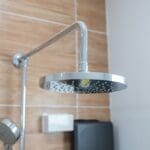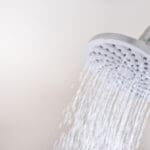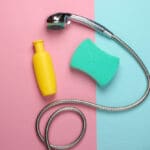Dealing with a leaking shower head is like trying to ignore a dripping faucet at midnight—it’s annoying and hard to overlook. You’ve noticed the persistent drip, drip, drip, and now you’re ready to tackle it head-on.
First, you’ll need to cut off the water supply to prevent a miniature Niagara Falls in your bathroom.
Next, it’s crucial to disassemble the shower head and inspect it for the usual suspects: a worn-out washer or a compromised O-ring. These are often the culprits behind the leak and are relatively straightforward to replace.
But before you dash off to solve this watery woe, remember that the devil is in the details. Understanding the specifics of each step can save you from a repeat performance of today’s plumbing symphony. Stick around to uncover the nuances that make these steps foolproof, ensuring your shower head remains a source of relaxation, not frustration.
Key Takeaways
- Check for loose connections, mineral buildup, and damage in the shower head.
- Disassemble and inspect the shower head, washers, and valve for any issues.
- Clean or replace parts as needed, such as soaking in a soap solution to remove mineral deposits.
- Reassemble the shower head tightly, following manufacturer instructions, and check for leaks.
Identify the Issue
Before tackling a leaky shower head, it’s crucial to pinpoint the root cause of the problem.
Start by checking for any loose connections between the shower head and the shower arm that might cause water to leak. Often, a dripping showerhead is simply the result of a connection that needs tightening.
Next, examine the shower head for mineral buildup, which can clog the nozzles and cause water to escape in unintended ways. If you spot any, it’s a clear sign of what’s making your showerhead to leak.
Don’t overlook the possibility of a cracked or damaged shower head or a faulty gasket. These issues can directly lead to a leaking shower head. To identify the issue, carefully inspect these components for any signs of wear or damage.
Additionally, consider the installation quality of your shower head. Improper installation can leave it prone to leaks.
Disassemble and Inspect
To start disassembling and inspecting your leaky shower head, first ensure it’s turned off and carefully remove it from the shower arm. Begin by unscrewing the shower head by hand to avoid causing any damage. If it’s tightly fixed, gently use pliers but protect the shower arm with a cloth to prevent scratches.
Once you’ve removed the shower head, it’s crucial to inspect several components for any signs of wear or damage:
- Look for any signs of corrosion or cracks on the shower head itself.
- Check the rubber washers and O-rings within the shower faucet for wear and tear.
- Examine the shower cartridge and valve body for any damage.
These components are vital for the proper functioning of your shower head, and identifying issues early can save you from further damage and more costly repairs later. If you find any damaged parts, replace them before reassembling the shower head.
Wrap thread-sealing tape around the shower arm threads before screwing the showerhead back on, ensuring a tight and leak-free fit.
Clean or Replace Parts
After disassembling and inspecting your shower head, the next step is thoroughly cleaning or replacing any damaged parts. If you’ve found mineral deposits clogging the nozzle, it’s time to remove those blockages. Soak the shower head in a soap solution for a few hours to dissolve the buildup. This simple step can often restore proper water flow and fix a leaky shower head without the need for replacement parts.
However, if cleaning doesn’t do the trick, you’ll need to check the rubber washer and O-rings. These parts can wear out over time, leading to leaks. Use a screwdriver to carefully remove and inspect them. If they’re damaged or worn, replace them with new ones to ensure a tight seal.
Additionally, inspect the diverter valve and the shower cartridge. If you spot any cracks, corrosion, or other signs of damage, it’s time for a new cartridge or valve. Replacing these parts can be a bit more complex, so make sure you have the right tools and follow the manufacturer’s instructions closely.
Once you’ve cleaned or replaced the necessary parts, reassemble your shower head using thread-sealing tape for an extra tight seal. Finally, turn on the water and check for any leaks to ensure your repair was successful.
Frequently Asked Questions
How Do I Get My Shower Head to Stop Dripping?
To stop your shower head from dripping, first turn off the water supply. Then, remove the shower head, inspect for damage, and replace any faulty parts. Reassemble, reattach, and check if it’s fixed.
How Do You Fix a Bad Shower Head?
To fix a bad shower head, you’ll need to first turn off the water supply, then unscrew the shower head to inspect and replace any damaged parts. Finally, reattach it securely to prevent future leaks.
How Do You Fix a Shower Head Seal?
To fix a shower head seal, you’ll need to unscrew the shower head, replace the faulty seal or O-ring, and reapply thread sealant before screwing it back on. It’s a simple, do-it-yourself fix.
Why Is My Shower Leaking When I Turn It Off?
Your shower leaks when turned off likely due to high water pressure, a loose connection, or mineral buildup. These issues can often be fixed quickly, ensuring your shower operates efficiently without unwanted dripping.





